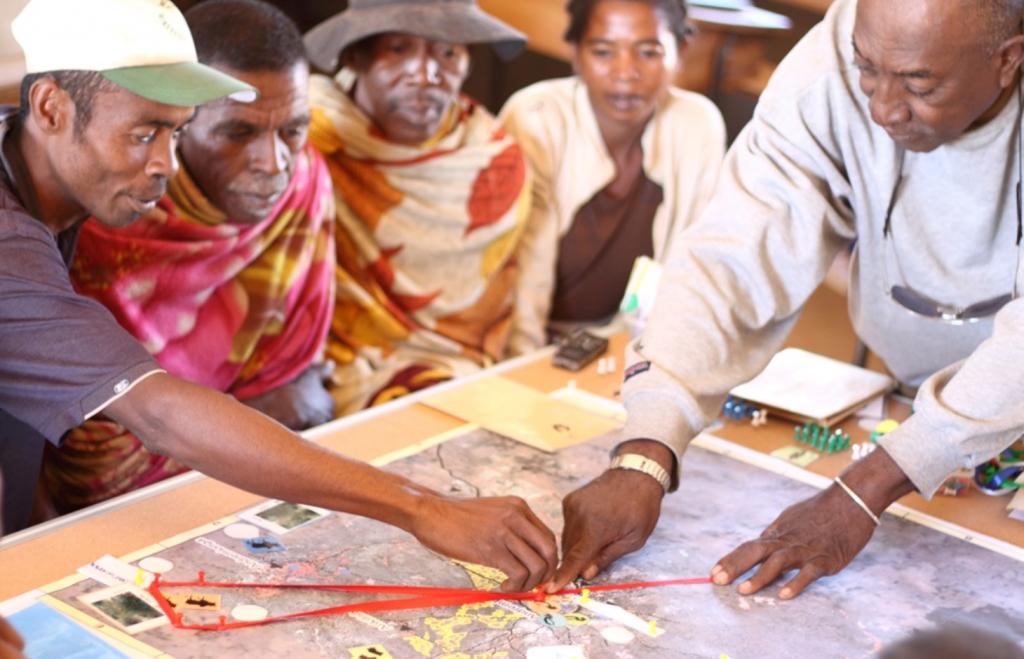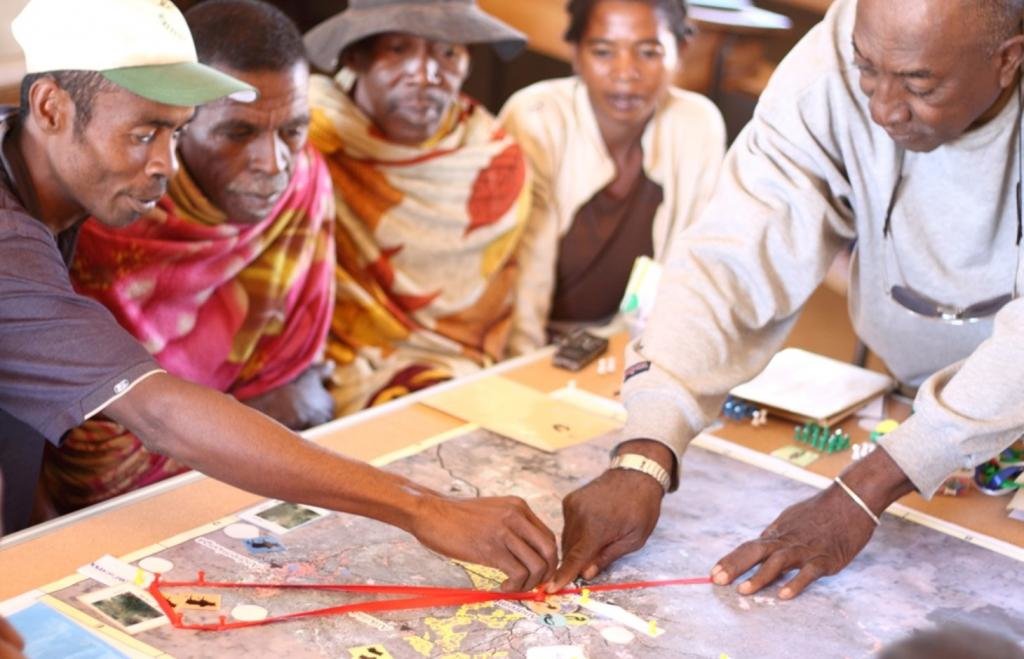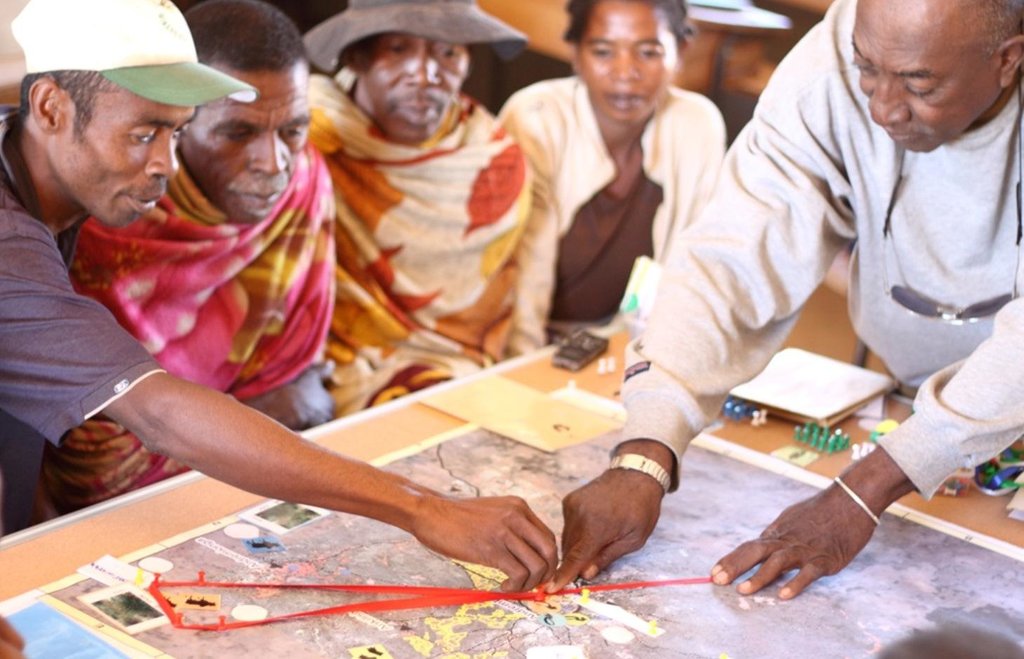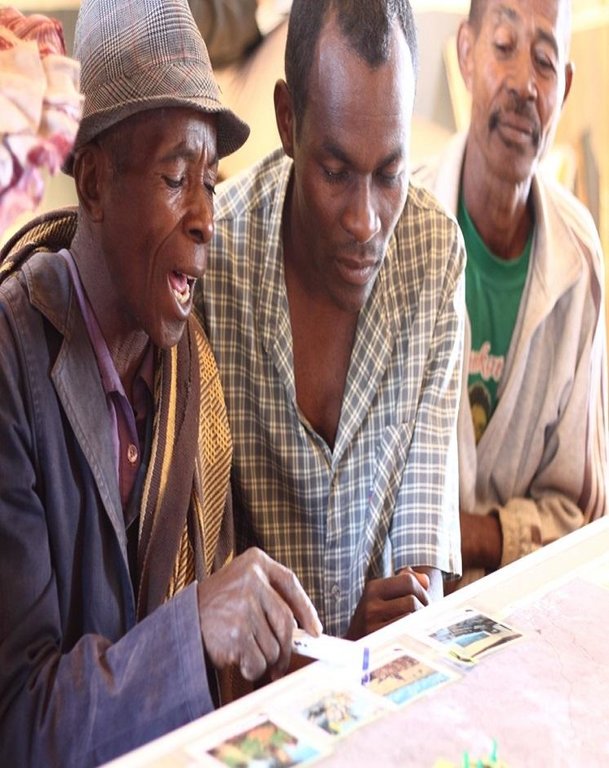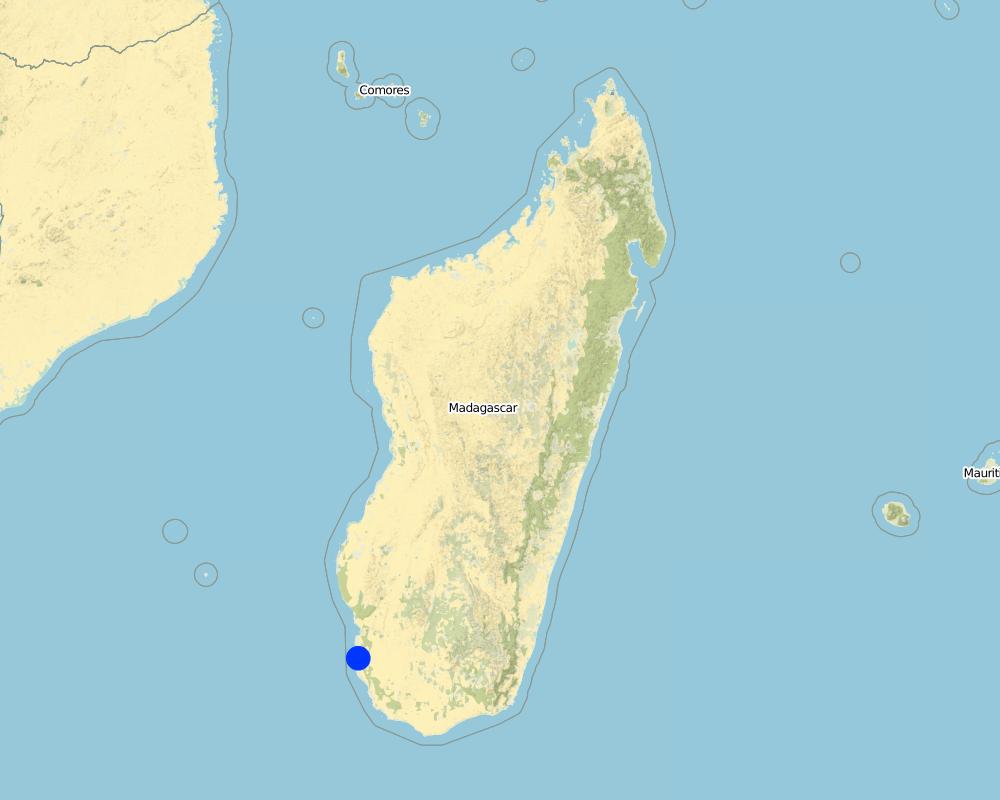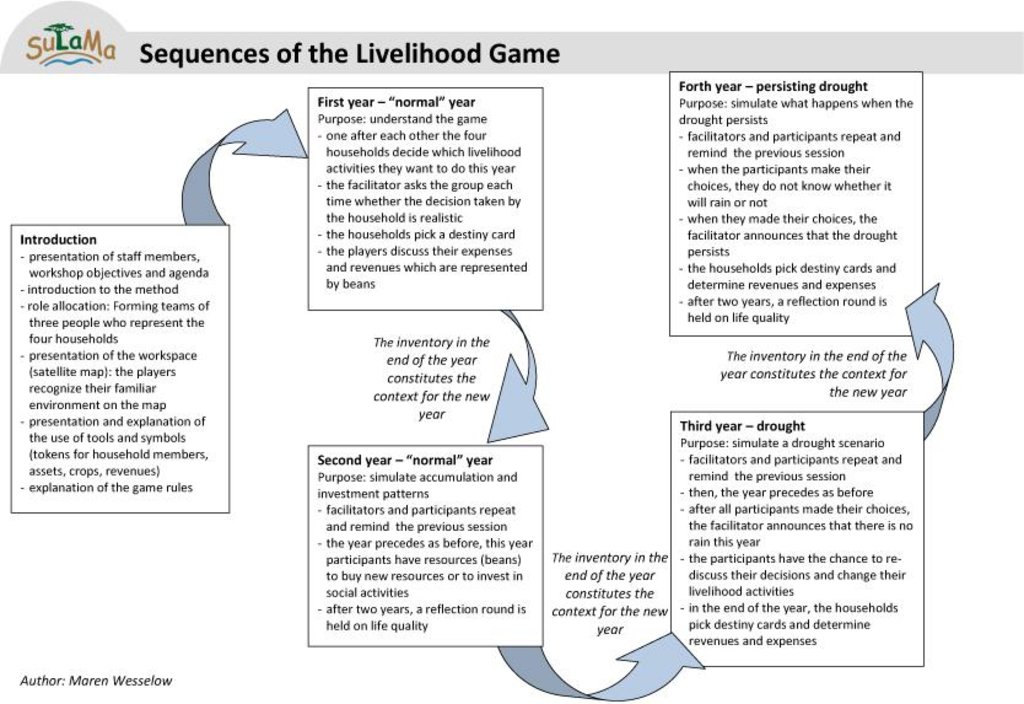Role-Playing Games in Natural Resource Management [马达加斯加岛]
- 创建:
- 更新:
- 编制者: Maren Wesselow
- 编辑者: –
- 审查者: Fabian Ottiger
approaches_2600 - 马达加斯加岛
查看章节
全部展开 全部收起1. 一般信息
1.2 参与方法评估和文件编制的资源人员和机构的联系方式
SLM专业人员:
Razafindramonja Mahaleo Claude
mahaleo.claude@gmail.com
Université de Tuléar
马达加斯加岛
SLM专业人员:
Babarezoto Fenohaja
babarezotofenohaja@gmail.com
Université de Tuléar
马达加斯加岛
SLM专业人员:
Rakotondranary Jacques
jacques.rak@gmail.com
Université de Antananarivo
马达加斯加岛
有助于对方法进行记录/评估的项目名称(如相关)
Sustainable Landmanagement in south-western Madagascar (SuLaMa / GLUES)有助于对方法进行记录/评估的机构名称(如相关)
University of Greifswald (University of Greifswald) - 德国有助于对方法进行记录/评估的机构名称(如相关)
University of Antananarivo - 马达加斯加岛有助于对方法进行记录/评估的机构名称(如相关)
Université de Tuléar - 马达加斯加岛1.3 关于使用通过WOCAT记录的数据的条件
(现场)数据是什么时候汇编的?:
01/08/2014
编制者和关键资源人员接受有关使用通过WOCAT记录数据的条件。:
是
2. SLM方法的描述
2.1 该方法的简要说明
Participatory simulation to foster stakeholder dialogue in natural resource management, conciliate resource conflicts and enable participatory land use planning
2.2 该方法的详细说明
该方法的详细说明:
Aims / objectives: Two role-playing games were designed to understand land users' livelihoods strategies in both “normal” but also in times of drought events and cattle raids. The aim was to find out how, and why, livelihood decisions differed between household types in south-western Madagascar. Under the role-playing methodology, land users actively participate through discussing livelihood strategies, negotiating interests, and planning for the future. The methodology proved to be very dynamic, interactive and useful.
Methods: The SuLaMa project is a five-year Malagasy and German research project involving an interdisciplinary team (consortium) that aimed at developing sustainable land use techniques in south-western Madagascar. To validate soft-models that fed into computer-based models on land use change in the region, four workshops were held in four villages on the Mahafaly Plateau. Two groups of land users, with twelve participants each, worked simultaneously in each village: a total number of 96 participated. The games, ‘Livelihood Game’ and ‘Livestock Game', were designed to foster both scientific knowledge production on land use systems, and dialogue with land users. The essence of the methodology is that participants assume the roles of different household types and simulate their annual livelihood activities on a village map. The four household types differed from relatively wealthy (owning cattle; a lot of land) to poor (no cattle, little land). Each household type was represented by two or three participants and roles were allocated randomly.
Stages of implementation: The 'Livelihood Game' covers a time span of four fictive years. Each round represents the household’s annual subsistence decisions. In contrast, the 'Livestock Game' covers just one year with each round encompassing one of three seasons. In the 'Livelihood Game', players have a set of activity options: for example they can locate fields on the map and choose how to cultivate them. Moreover, additional activities like livestock keeping, charcoal making, paid work, collecting/hunting or educating children are available to them. The 'Livestock Game' concentrates on grazing and animal feeding decisions. Each decision is visualized by pictured cards, tokens and symbols - and grazing areas are mapped. While this participatory simulation remains a game, it would be feasible to integrate the methodology into a land use planning process.
Role of stakeholders: Initially, the joint interdisciplinary team conducted a baseline survey using Rapid Rural Appraisal tools to gain a general understanding of local socio-ecologic systems. Following this, a quantitative household survey was carried out in several villages (665 households in total) to analyse household composition and structures. Based on the results, researchers designed the structure of the role-playing games.
Other important information: A crucial precondition was that local communities were well-informed and participation was voluntary. This was achieved by an ‘announcement tour’ where timings were adapted to social, cultural and labour schedules of the local population. The communities were invited to determine the participants according to specific criteria. Participants had to be those who practiced the typical livelihood activities of agriculture and livestock keeping, and who contributed to household decision-making. Furthermore, a balance in terms of gender, age and lineage was requested.
2.3 该方法的照片
2.5 采用该方法的国家/地区/地点
国家:
马达加斯加岛
区域/州/省:
Mahafaly Plateau, South-Western Madagascar
有关地点的进一步说明:
Betioky-Atsimo
Map
×2.6 该方法的开始和终止日期
注明开始年份:
2014
终止年份(若不再采用该方法):
2015
2.7 方法的类型
- 基于项目/方案
2.8 该方法的主要目的/目标
The Approach focused mainly on other activities than SLM (Participation, stakeholder communication, joint natural resource management, mutual learning)
The community workshops were held in order to (1) validate the researchers’ systems understanding about rural livelihoods and land use activities, and to (2) discuss land users' responses to drought events and cattle raids.
The SLM Approach addressed the following problems: Lack of communication and negotiation between technicians, resource users and scientists. Lack of participation of rural communities in long-term planning and decision-making. Lack of regulations for the use of scarce resources.
2.9 推动或妨碍实施本办法所适用的技术的条件
社会/文化/宗教规范和价值观
- 阻碍
In this rural region, governmental decision-making authorities are mostly absent. Decision-making processes in the local communities follow traditional hierarchies and structures. Men and old people generally have a greater decision-making power than women and young people.
Treatment through the SLM Approach: External actors organized the workshops. They controlled group composition so that it was balanced in terms of gender, age, and lineage.
法律框架(土地使用权、土地和水使用权)
- 启动
Resource and land ownership was a topic during the Role-Playing Games. Problems on conflicts could be detected and discussed, but not always solved.
其他
- 阻碍
Rural livelihoods in the Mahafaly region are vulnerable. Rainfed agriculture and livestock keeping constitute the mainstay of virtually all households. Low and unpredictable precipitation limits agricultural production. Recurrent droughts lead to harvest failures and put a major threat to rural livelihoods. Moreover, people are faced with the problem of organized and armed cattle raiders. In fear of being robbed, herders adjust their grazing grounds and paths.
Treatment through the SLM Approach: Participants could relate the simulation to
real-life. They were enabled to analyse their household management systems and to develop coping strategies to address drought periods.
Participants discussed commonly how to respond to the risk of cattle raids in the region.
3. 相关利益相关者的参与和角色
3.1 该方法涉及的利益相关者及其职责
- 当地土地使用者/当地社区
land users from the villages
When selecting the participants, a balance in gender, age and lignage was asked.
- 地方政府
traditional village authorities
- 国家政府(规划者、决策者)
- 国际组织
German-Malagasy research consortium
如果涉及多个利益相关者,请注明领导机构:
The Livelihood Game and the Livestock Game were designed by researchers on the basis of their previous findings.
3.2 当地土地使用者/当地社区参与该方法的不同阶段
| 当地土地使用者/当地社区的参与 | 指定参与人员并描述活动 | |
|---|---|---|
| 启动/动机 | 无 | |
| 计划 | 无 | |
| 实施 | 互动 | Villagers participated in the workshops. As compensation for their time, they received a community remuneration. |
| 监测/评估 | 互动 | After the workshops, participants were asked to give feedback on the methodology. |
| Research | 无 |
3.3 流程图(如可用)
具体说明:
The flow chart demonstrates the different sequences of the Livelihood Game at is was played in the workshops 2014. After an introduction, four years were simulated. Each year has a different purpose: The years one and two can be classified as 'normal' years, whereas year three and four are drought years. While year one serves to understand the game, the second year is to simulate accumulation and investment patterns. The third year consitutes a drought year which means harvest failure for the households. In the forth year, participants simulate their behaviour in the scenario of a persisting drought.
作者:
Maren Wesselow
3.4 有关SLM技术选择的决策
具体说明谁有权决定选择要实施的技术:
- 主要是土地使用者,由SLM专家提供支持
解释:
During the simulations, land users decided which activities they carried out to feed their (fictive) households. A set of predetermined activities was available to them. The discussions were moderated by a facilitator.
Decisions on the method of implementing the SLM Technology were made by by SLM specialists alone (top-down). The SuLaMa research project decided to use the Role-Playing Games methodology to trigger discussion among and with land users. Within the simulation, land users strongly influenced the game process by decidion on their household activities.
4. 技术支持、能力建设和知识管理
4.1 能力建设/培训
是否为土地使用者/其他利益相关者提供培训?:
是
明确受训人员:
- 土地使用者
- research assistants, WWF staff
培训形式:
- 在职
- 农民对农民
培训形式:
- 'Learning by doing and failing'
涵盖的主题:
Research assistants and WWF staff were trained to facilitate and document the method adequately.
During the workshop sessions, land users gained understanding of the interdependencies of land use and conservation practices and came to reflect the livelihood strategies in their villages.
4.2 咨询服务
土地使用者有权使用咨询服务吗?:
是
说明/注释:
Participatory simulations, role-playing games; Key elements: Taking on another households' role, Developping livelihood strategies in different scenarios, Discussion, communication and negotiation
4.3 机构强化(组织发展)
是否通过这种方法建立或加强了机构?:
- 否
4.4 监测和评估
监测和评估是该方法的一部分吗?:
是
注释:
technical aspects were regular monitored by project staff through observations; indicators: data on land use practices were collected
socio-cultural aspects were regular monitored by project staff through observations; indicators: data on human well-being and social conventions (traditions, rituals) were collected
economic / production aspects were regular monitored by project staff through observations; indicators: data on expenses and revenues were collected
area treated aspects were regular monitored by project staff through observations; indicators: spatial decisions were visualised and marked on maps
no. of land users involved aspects were regular monitored by project staff through observations; indicators: in each of the 4 villages 24 land users took part in the workshops
management of Approach aspects were regular monitored by project staff through observations; indicators: qualitative and quantitative data on livelihood strategies were collected
There were few changes in the Approach as a result of monitoring and evaluation: To synchronize the process in the two groups within a village, it was essential to have one observer who could move between the two groups and detect differences. For instance, it was observed that while one facilitator preferred to gather all participants around one big table, the other one arranged separate tables for each household. After the workshop sessions, observers, facilitators and documenters discussed the process and crosschecked the results of different groups. Eventually, it was agreed that it was better to have all participants around one big table. Also household assets, such as poultry or houses, were adopted in the game by the players.
4.5 研究
研究是该方法的一部分吗?
是
- households' livelihood strategies
提供进一步的细节,并指出是谁做的研究:
An international research consortium conducted the Role Playing Game workshops to validate human decisions in their land use models. However, the approach can be applied for various purposes.
Research was carried out on station
5. 融资和外部物质支持
5.1 该方法中SLM组成部分的年度预算
如果不知道准确的年度预算,请给出一个范围:
- 2,000-10,000
注释(例如主要的资助来源/主要捐助者):
Approach costs were met by the following donors: international (German Ministry of Education and Research (BMBF)): 100.0%
5.2 为土地使用者提供财政/物质支援
土地使用者是否获得实施该技术的财政/物质支持?:
是
5.3 对特定投入的补贴(包括劳动力)
- 设备
| 具体说明哪些投入得到了补贴 | 程度如何 | 对补贴做出具体说明 |
|---|---|---|
| 工具 | 充分融资 | maps, toolkits with pictured cards, tokens, etc. |
如果土地使用者的劳动力是一项重要的投入,那么是不是:
- 自愿
注释:
Participants were paid expense allowance for the workshop days.
5.4 信用
是否根据SLM活动的方法给予信用值?:
否
6. 影响分析和结论性陈述
6.1 方法的影响
该方法是否帮助土地使用者实施和维护SLM技术?:
- 否
- 是,很少
- 是,中等
- 是,支持力度很大
Participants stated that they learned about each other’s livelihood strategies and the long-term impacts. One participant in Andremba stated (2014): “For us this game is like a lesson that makes us understand what happens in our lives. It is a reflection game that makes us think about our lives and our way of life with our subsistence activities and income sources.”
该方法是否有助于社会和经济弱势群体?:
- 否
- 是,很少
- 是,中等
- 是,支持力度很大
People of mixed age, gender and lineage participated in the simulations.
Did other land users / projects adopt the Approach?
- 否
- 是,很少
- 是,中等
- 是,支持力度很大
So far the approach has only be tested once by researchers. However, interested practice organizations may adopt and develop the method in the future.
Did the Approach lead to improved livelihoods / human well-being?
- 否
- 是,很少
- 是,中等
- 是,支持力度很大
The approach primarily triggers land user involvement, but not directly affects their livelihoods.
Did the Approach help to alleviate poverty?
- 否
- 是,很少
- 是,中等
- 是,支持力度很大
Although there is no direct linkage between participation and poverty alleviation, the approach may raise awareness of development and conservation issues and, community learning and empowerment.
6.2 土地使用者实施SLM的主要动机
- 规章制度(罚款)/执行
The approach may help to negotiate rules and regulations in natural resource management.
- 环境意识
The approach may raise awareness for ecosystem services and their degradation
- Participation, communication
Participation of land users in science and implementation processes as well as communication between
6.3 方法活动的可持续性
土地使用者能否维持通过该方法实施的措施(无外部支持的情况下)?:
- 否
若否或不确定,请具体说明并予以注释:
As the methodology needs preparation and facilitations, some method specialists are required to accompany the process.
6.4 该方法的长处/优点
| 土地使用者眼中的长处/优势/机会 |
|---|
| The participants understood and generally accepted the game rapidly. They confirmed to have recognized that it was not just a game but a simulation of reality. As all the activities referred to the people’s everyday life, no long introduction or explanation was necessary to start the game. People seemed to feel comfortable in their “roles” and spoke freely about their household decisions. They could actively take part in the game not only by answering to the questions but also by manipulating the game materials on their own. . “This game is easy, because it refers to our daily life, not to something you have created for yourself. This is the reality of our daily lives.” (Participant in Efoetse, August 2014) |
| 编制者或其他关键资源人员认为的长处/优势/机会 |
|---|
|
The Role Playing Game became vivid and lively by using visualization and communication tools. Complex decisions on land use system could be explained with the help of pictures and symbols from people’s daily life. The tools not only helped to capture the whole systems complexity and open discussions, they also assured mutual understanding and synchronized different agents’ perception. Pictures also helped to achieve a common understanding beyond language barriers. In a region with a high illiteracy rate, these visualization tools can be regarded as measures for empowerment as no writing or reading skills are necessary to take part in the game. Thus, the method is a dynamic and interactive tool for stakeholder integration and awareness raising. |
6.5 该方法的弱点/缺点以及克服它们的方法
| 土地使用者认为的弱点/缺点/风险 | 如何克服它们? |
|---|---|
| The methodology is time consuming and brings no direct or sudden benefits for land users. | The method could potentially be changed so that results are less research-oriented and more visible for the participants. Now technologies or alternative livelihood activities could be simulated during the game. |
| 编制者或其他关键资源人员认为的弱点/缺点/风险 | 如何克服它们? |
|---|---|
| It must be mentioned that a lot of investment and preparation is needed for conducting the workshop successfully. The Role-Playing Game not only requires very specific material and tools, but also a lot of time for development, preparation, team training, testing and on-site execution is required. If the time needed for carrying out the game cannot be planned and tested carefully in advance, it may lead to frustration and disappointment. | The benefits of this approach need to be justified and proved to donors and the extension / advisory services to convince them to invest. |
| Though the methodology was generally accepted and understood, it turned out to be challenging for facilitators and documenters. It requires high communication skills, empathy, and understanding for local conditions and the willingness to listen to the peasants in order to build trust among the group. | To become good facilitators, capacity building and training of extension workers or advisors is needed. |
| The role-playing games methodology is laborious to design and prepare, it usually needs one dedicated institution to initiate and coordinate the workshops. | The only option for continuing this methodology is if a generally-accepted and professional organisation can be found to take on the responsibility in the long term. |
7. 参考和链接
7.1 方法/信息来源
- 实地考察、实地调查
- 与土地使用者的访谈
7.2 参考可用出版物
标题、作者、年份、ISBN:
Wesselow et al. 2015: Participatory Gaming for Sustainable Land Management in the Mahafaly Region. A Practical Guide for Researchers and Practitioners
可以从哪里获得?成本如何?
http://www.sulama.de/files/products/WP5_Product3_Participatory_Gaming_for_SLM_eng.pdf
链接和模块
全部展开 全部收起链接
无链接
模块
无模块


